Fern lovers across the country are truly spoilt for choice when it comes to their picks of fantastic Australian ferns. In saying that, I also think we have an attractive and diverse array of introduced ferns that have readily adapted to our various endemic regional climates.
What I found so functional about ferns is that most species are evergreens with the ability to elevate both indoor and outdoor spaces year-round with their fanciful foliage. Ferns offer a delicate elegance. They are textured and lively plants, often decorated with vibrant fronds and variegated foliage.
With so many beautiful introduced and Australian native ferns to choose from, it can be a little overwhelming to decide which are right for your living spaces. Not to worry, in this article, I will be highlighting 20 of the best and most popular ferns to grow in Australia in the hopes I can make your search a little easier.
More...
About Australian Ferns
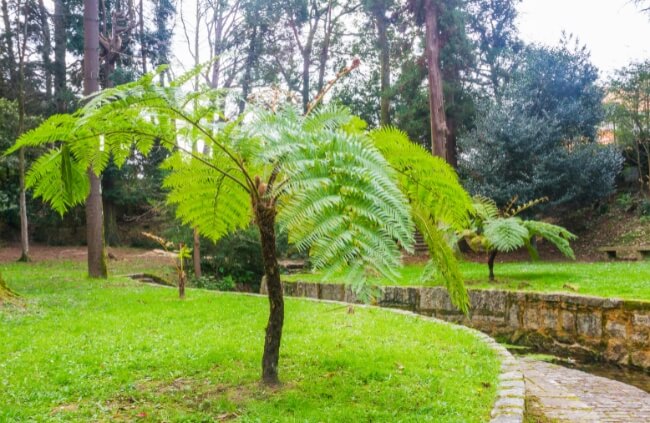
Australian flora consists of close to 400 species of ferns, with about 103 genera and around 30 families. Needless to say, there’s certainly a fern out there for everyone.
Ferns come in a wide range of growing habits, forms, and sizes, making them ideal picks for almost any landscaping application. Whether you’re looking for a large feature in your garden or an adorable potted specimen for your kitchen, we’ve got you covered.
Benefits of Using Australian Ferns Indoors
- Ferns tend to enjoy humidity
- They offer textured and ornamental appeal to any living area
- They can absorb heavy metals and pollutants from the air
- They are lively plants in that their fronds move with watering and light
- Ferns also improve humidity by restoring moisture to the air naturally
- They are low-maintenance, easy-to-grow plants
Benefits of Using Australian Native Ferns Outdoors
- Ferns provide a valuable contribution to the ecosystem in which they live
- They can provide shelter, shade, and erosion protection to gardens
- Many beneficial garden insects create microhabitats in and around ferns
- Their textured and unique foliage can easily boost the aesthetic appeal of any outdoor space year-round
- Their air-purifying properties are also beneficial outdoors
- Delicate fronds offer a refreshing greenness to gardens
Common Landscaping Applications Using Australian Ferns
Ferns make for great additions to both indoor and outdoor spaces. While they aren’t prized for their flowers, it’s their spectacular foliage that’s so sought after.
Here are some common uses for ferns in homes and gardens:
- Feature plants (especially larger species)
- Border planting
- Gap-filling
- Indoor pots or hanging baskets
- Container gardening
- Planted for shade in gardens
- Used to decorate shelves, kitchens, bathrooms, patios and more
20 Types of Australian Ferns
1. Foxtail Fern – Asparagus densiflorus
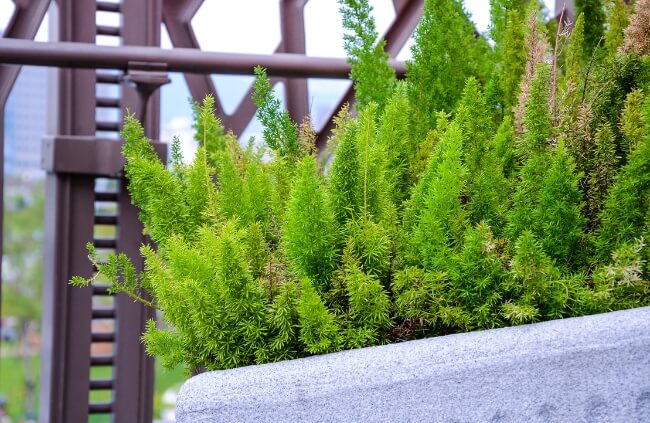
Perhaps one of my personal favourite introduced species, the Foxtail Fern is a highly attractive evergreen plant with a useful upright and clumping habit, as well as utterly striking needle-like leaves that are borne on vibrant green thick and bushy stems.
Makes for an ideal houseplant or groundcover in garden beds. Will also look fantastic in hanging baskets.
- Origin: South Africa
- Size: 0.5 to 1 metre tall, 1 to 1.5 metres wide
- Sun: Requires partial shade inland and full sun on the coast
- Soil: Plant into well-drained, slightly acidic soil or a quality potting mix
- Care: Water well but only when topsoil has dried to the touch. Avoid using harsh fertilisers and rather use organic compost as needed. Try to avoid temperatures below 10°C.
2. Silver Fern – Cyathea dealbata
Endemic to New Zealand, the popular Silver Fern features absolutely striking silvery foliage, as you may have guessed. It is considered a species of tree fern in Zealand and is also the national symbol of the country.
Its fronds extend upwards with a graceful elegance, offering highly ornamental appeal to outdoor spaces.
- Origin: New Zealand
- Size: 6 to 10 metres tall, up to 4 metres wide
- Sun: Full sun to semi-shade
- Soil: Prefers a light sandy soil or a medium loam soil
- Care: Water well at the base in summer then reduce in winter. Feed with a seaweed fertiliser, bone meal, or well-rotted manure from spring to summer.
3. Boston Fern – Nephrolepis exaltata

Also known as the Sword Fern, this globally adored species sports luscious evergreen, sword-shaped fronds with many small leaflets that gently arch and drape as they grow.
Perfectly suited to many Australian climates, Boston fern performs well in warm and tropical conditions. Will grow well indoors or outdoors if the growing conditions are decent.
- Origin: Central and South America, West Indies
- Size: Up to a metre tall and wide
- Sun: Needs bright indirect light for at least 2 to 4 hours every day
- Soil: Grow best in slightly acidic, well-drained soil that retains good moisture (loam soil or potting mix)
- Care: Water well when the top 3 cm of soil has dried to the touch. Water at the base to avoid getting the fronds soaked. Fertilise monthly with a balanced garden fertiliser or houseplant fertiliser from spring to summer.
4. Maidenhair Fern – Adiantum
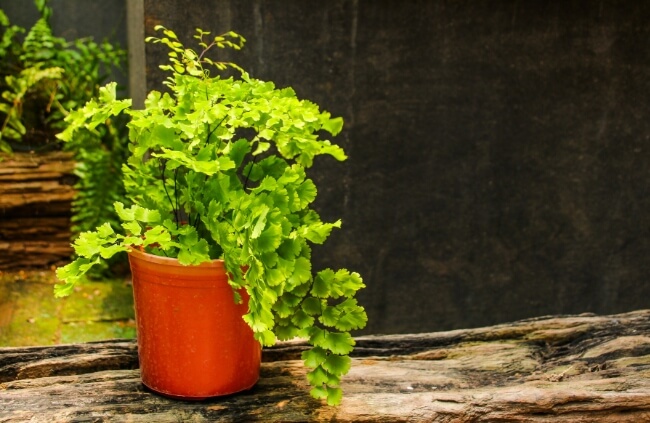
This small and delicate fern is one of our most cherished Australian ferns. Maidenhair ferns are perfect when used as indoor companion plants or left relaxing in shaded gardens.


Get Your Free Guide:
Master Growing Australian Natives eBook
A Must Have Complete Guide for Every Australian Garden
Get Your Free Guide:
Master Growing Australian Natives eBook
A Must Have Complete Guide for Every Australian Garden
The delicate fan-shaped leaves offer wonderful texture, and the plant will look marvellous all year long.
- Origin: Native
- Size: 30 to 60 centimetres tall and wide
- Sun: Flourishes in dappled sunlight to full shade
- Soil: Grows best in enriched well-drained soil or quality potting soil
- Care: Water to keep the soil slightly moist at all times and fertilise only in poorer conditions with a slow-release granular fertiliser.
5. Birds Nest Fern – Asplenium nidus
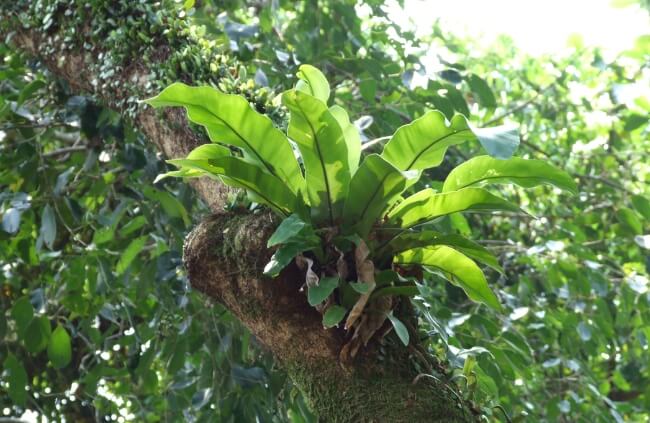
Featuring luscious spoon-shaped fronds that extend from a rosette centre, the Birds Nest Fern is another one of our most admired Australian native ferns. It is a great pick for beginners and indoor environments, offering a lovely leafy and lively appeal.
- Origin: Native
- Size: Up to 1.5 metres tall and wide outdoors, and up to 60 centimetres tall and wide indoors
- Sun: Part shade to full shade (avoid harsh direct light)
- Soil: Can tolerate a wide range of soils so long as the soil is well-drained and rich in organic matter
- Care: The plant enjoys warmth, humidity, and moisture. Water when topsoil feels dry and feed with a balanced, water-soluble houseplant fertiliser in summer.
6. Australian Tree Fern – Cyathea cooperi
This gorgeous specimen is one of my most prized garden tree ferns. It is a fast-growing, single-trunked fern with a tall and elegant form and long spreading fronds. It is perfect for creating attractive canopies and silhouettes throughout gardens, offering a very tropical influence to outdoor spaces.
- Origin: Native
- Size: 5 to 15 metres tall, up to 8 metres wide
- Sun: Dappled sun to light shade (full sun only in cooler climates)
- Soil: Plant in moist, humus-rich soil that is well-draining. Prefers high soil moisture
- Care: Water to keep the soil moist at all times and feed monthly with a balanced liquid fertiliser
7. Staghorn Fern – Platycerium spp.

Also known as Elkhorn ferns, these plants boast dramatic foliage and spectacular structures. Its fronds are very singular in appearance, with structural basal fronds that exist to protect the roots from harsh light.
Fronds appear with an attractive curved and twisted form. There are many beautiful species to choose from and these ferns are ideal for hanging baskets, pots, or garden beds.
- Origin: Native
- Size: Up to 4 metres tall and wide
- Sun: Part shade is preferred
- Soil: Plant into well-drained soil that retains good moisture levels
- Care: Water once the planting medium starts drying and fertilise in spring
8. Kimberly Queen Fern – Nephrolepis obliterata
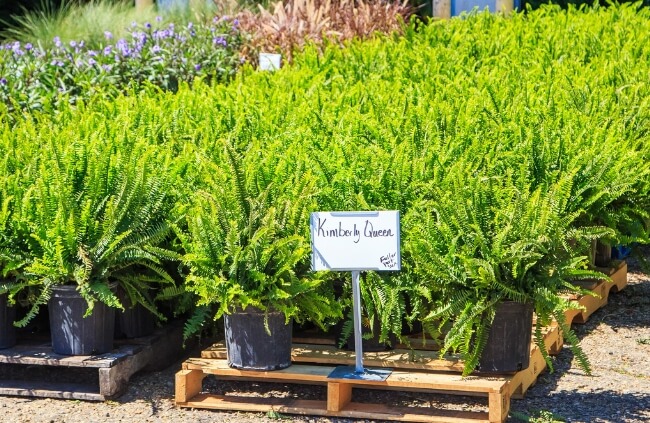
I adore how the elegant large sword-shaped fronds rise from the short hairy leaf stems of this plant. Like its relatives, this fern produces upright glossy fronds heavily decorated with small, bladelike leaflets.
Perfect for hanging baskets, and pots, or use outdoors, this species will certainly impress.
- Origin: Native
- Size: 1 to 1.5 metres tall and wide
- Sun: Bright indirect light indoors and dappled sunlight outdoors
- Soil: Grows best in a well-drained, alight acidic soil or a free-draining potting medium
- Care: Water to keep soil evenly moist, watering weekly on average. Fertilise monthly during the growing season with a balanced plant food.
9. Gristle Fern – Blechnum cartilagineum
This is an excellent fern to help suppress weeds when used as a ground cover in gardens. It produced exciting new growth that emerges in pink and bronze, eventually settling to a lush green colour.
It has a compact and dense growth habit, perfect for adding some greenery to indoor and outdoor spaces.
- Origin: Native
- Size: Up to 1 metre tall and wide
- Sun: Dappled sun to bright indirect light
- Soil: Prefers a rich and damp soil that has a balanced pH level. A light loamy soil or potting mix should be perfect
- Care: Will need about a litre of water every two weeks. Feed with a water-soluble fertiliser bi-annually.
10. Holly Fern – Cyrtomium falcatum

Another one of our favourite introduced Australian ferns, the Holly Fern is very hardy and produces gorgeous glossy fronds up to 60 cm long. The fronds appear with a striking spiral-like form, ideal for adding interest and density to garden beds or indoor living areas.
It is considered one of the most attractive and easy-to-grow ferns in its native land.
- Origin: Southern Asia
- Size: Up to a metre tall and wide
- Sun: Dappled sun to bright indirect light (avoid full sun as fronds are prone to scorching)
- Soil: Loves evenly moist soil with good drainage
- Care: Water when the top 5 cm of soil becomes dry and feed with a balanced fertiliser from spring to autumn every 3 weeks.
11. Kangaroo Paw Fern – Microsorum diversifolium
These Australian native ferns are cherished for their lush and tropical vibe. They make for excellent houseplants as they are easy to care for and offer unique appeal indoors with their glossy and graceful arching leaves.
Being rhizomatous, they are also easy to propagate using division.
- Origin: Australia and New Zealand
- Size: 30 to 60 centimetres tall and wide
- Sun: Dappled sun to bright indirect light
- Soil: Prefers moist soil but the soil must be well-draining as this species is susceptible to root rot
- Care: Water to keep the soil evenly moist at all times and fertilise every 4 to 6 weeks from spring to autumn with a balanced fertiliser.
12. King Fern – Angiopteris evecta
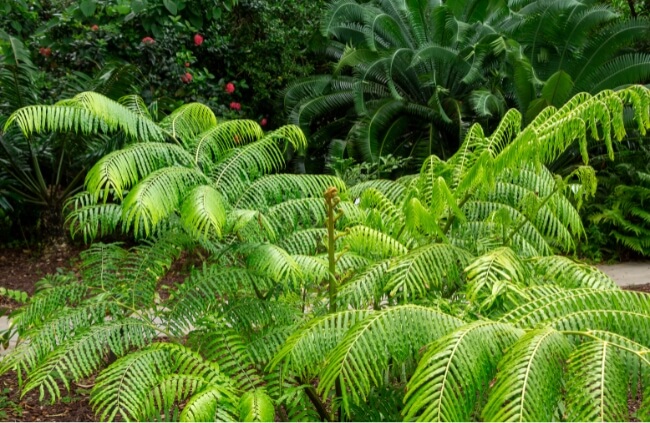
This stunning evergreen fern boasts some of the largest fronds known to ferns, reaching 2 to 5 metres in length in ideal conditions. Fluffy fronds crown the gently arching, bamboo-like stems of the plant, offering a highly decorative yet relaxing feel to outdoor spaces.
- Origin: Native
- Size: Up to 2 metres tall, up to 1.5 metres wide
- Sun: Partial shade to bright indirect light
- Soil: Requires rich moist soil and some organic mulch around the root ball in summer
- Care: Water well around the base of the plant in summer then cut back slightly in winter. Feed with a dynamic soil lifter from spring to autumn.
13. Mother Shield Fern – Polystichum proliferum
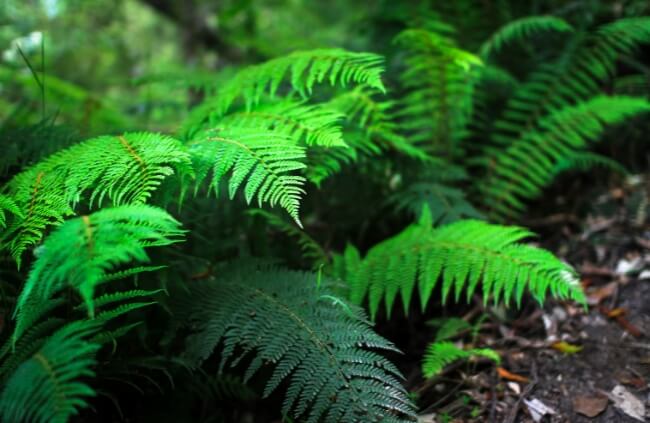
These prolific Australian native ferns feature an attractive clumping habit and erect tufted fronds filled with delicate and highly textured leaflets. Perfect when used as a border plant or around rockeries for additional appeal.
This species is also one of the few that are frost tolerant and it does tend to prefer cooler climates.
- Origin: Native
- Size: 1 to 1.5 metres tall and wide
- Sun: Indirect dappled sunlight
- Soil: Plant into an enriched soil that drains easily
- Care: Water the plant gently as needed to maintain a lightly damp environment and feed with an organic garden fertiliser from spring to summer.
14. Umbrella Fern – Sticherus cunninghamii

Characterised by its gently drooping fronds that resemble an umbrella, this species can easily add some charm and playfulness to your outdoor spaces. It may be hard to come by but if you do manage to find one, these introduced Australian ferns are certainly worth the time.
- Origin: New Zealand
- Size: Up to 5 metres tall and wide
- Sun: Dappled indirect light
- Soil: Can withstand poorer soils but prefers an enriched loamy soil
- Care: Water lightly to always keep the soil slightly moist.
15. Silver Hare’s Foot Fern – Humata tyermanii
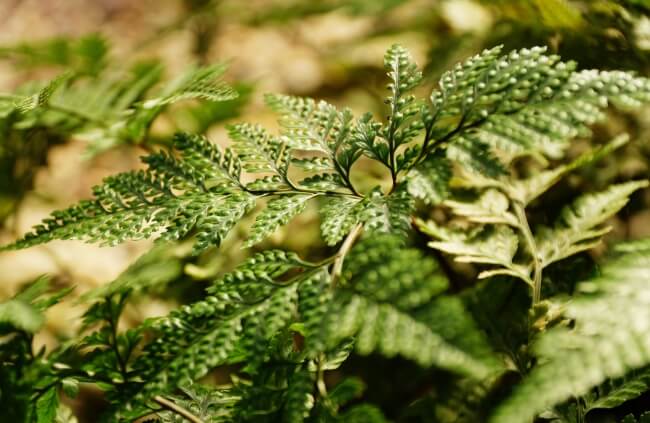
This small, fine-leafed fern features silvery-white rhizomes that love to creep along the surface of the soil or around the pot it's planted in. This particular species is perfect for hanging baskets or indoor containers that show off its gorgeous matted web of silvery foliage.
- Origin: Fiji
- Size: Up to 60 centimetres tall and wide
- Sun: Indirect light
- Soil: Prefers a loamy soil that retains good moisture with a neutral to slightly acidic pH level
- Care: Water moderately to keep the soil moist and fertilise with an organic fertiliser every 2 weeks during the growing period.
16. Soft Tree Fern – Dicksonia antarctica
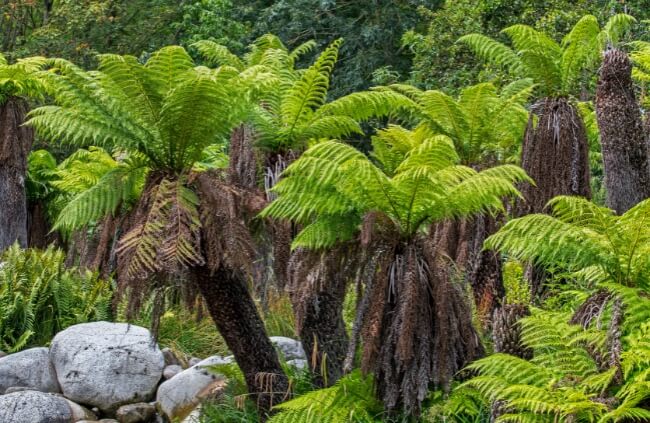
These large Australian ferns are perfect for larger landscapes. Dicksonia antarctica sport an attractive bulbous trunk that is adorned with reaching fronds that gently arch and sway with winds.
They require more pruning than most ferns but can add lovely silhouetted shade around the garden.
- Origin: Native
- Size: 5 to 15 metres tall, 1 to 3 metres wide
- Sun: Dappled light to full shade
- Soil: Plant in enriched well-drained soil (compost or humus can work great)
- Care: Keep the soil moist and provide additional water in summer. Fertilise with a slow release fertiliser in mid-spring.
17. Binung Fern – Christella dentata
Ideal for cultivation in shady gardens, the Binung Fern is a rapid grower and features lime-green tapering fronds that are coated with delicate, soft hairs. It is a hardy species, suited for adding fernery and texture to smaller gardens or cottage gardens.
- Origin: Native
- Size: Up to 1 metre tall and wide
- Sun: Requires a partly-shaded to fully-shaded position with some shelter
- Soil: It is adaptable to many soil types so long as the soil is moist and well-drained
- Care: Water well every 3 weeks or so and only fertilise if the plant is struggling.
18. Rough Tree Fern – Cyathea australis
These large growing Australian ferns are prized in parks and play areas across the country. The plant forms with a singular upright and slender trunk that is crowned with a beautiful rounded canopy, full of lovely textures and movement. Ideal when used as a feature in large gardens.
- Origin: Native
- Size: Up to 5 metres tall and 3 metres wide
- Sun: Can withstand some full sun but prefers slightly dappled daily light
- Soil: Plant in well-drained soil that is rich in organic materials
- Care: Water the crown and base often in summer but avoid watering the crown in winter. Feed monthly with a balanced liquid fertiliser during the growing season.
19. Button Fern – Pellaea rontundifolia
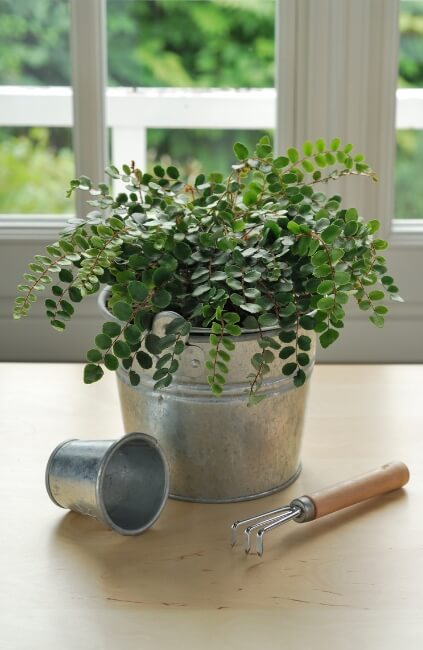
These Australian native ferns are ideal as houseplants as they are small, grow brilliantly in pots, and feature a low-growing habit with arching fronds filled with beautiful rounded leaflets.
The leaflets are serrated at their ends, adding to the plant's textured appearance. These guys love humidity so they would make a great companion plant in kitchens or bathrooms.
- Origin: Native
- Size: Up to 30 centimetres tall and wide
- Sun: Bright indirect light to shady (no direct sun)
- Soil: Use a quality potting medium for the best results
- Care: Water frequently but lightly to keep the soil moist but never soggy. Feed monthly with a balanced and water-soluble houseplant fertiliser from spring to summer.
20. Lacy Ground Fern – Dennstaedtia davallioides
This vigorous species produces extravagantly frothy foliage with fronds that resemble small Christmas trees. New growth emerges light green and settles to a pleasant emerald green, offering gorgeous pops of colours and textures to outdoor spaces.
- Origin: Native
- Size: 5 to 10 metres tall, up to 5 metres wide
- Sun: Prefers some soft morning and late afternoon sun with shelter from midday heat
- Soil: Plant into an enriched soil that retains good moisture like a sandy-loam soil
- Care: Water well then allow the top 2 cm of soil to dry before the next watering. Pale foliage could indicate that the plant is receiving too much harsh light.
Tips for Gardening with Australian Ferns
Ferns are mostly fuss-free plants, so they should be easy to grow and care for generally. Most introduced and Australian native ferns are also adaptable and tolerant to a range of growing conditions.
Humidity, moisture and lighting are the most curtailing aspects to consider both indoors and outdoors when dealing with ferns.
- For indoor ferns, kitchens and bathrooms tend to be ideal as these locations are usually more humid
- Harsh direct light should be avoided with most fern species
- Soil should always be enriched and well-draining while maintaining good moisture
- Planting sites should be at least twice as wide and to the same depth as the root ball
- Potted ferns may need repotting every 2 to 3 years to maintain healthy roots
- For larger tree ferns, some occasional much during hot summers can assist with adequate moisture retention in the soil
- Larger species may also require more regular pruning to encourage growth and maintain tidiness
Australian Ferns Frequently Asked Questions
How fast do Australian ferns grow?
Potted ferns will naturally grow slower than their garden counterparts, but overall, ferns are considered fast-growing flora with the ability to grow up to a metre per year.
How do you care for Australian ferns?
Most outdoor ferns prefer bright but indirect light daily with moderate to high humidity. They also tend to enjoy slightly moist soil at all times and a balanced fertiliser during their active seasons.
Are Australian native ferns suited for cooler climates?
Yes, certainly. Many beautiful Australian native ferns are ideal for cooler climates. The Maidenhair Fern and Birds Nest Fern are great picks to name a few.
What is an easy to grow fern in Australia?
The Birds Nest Fern and Foxtail Fern are particularly beginner-friendly options.
Do ferns grow better in pots or in the ground?
Ferns can grow well both potted and in a garden bed. It also depends on what species you’re looking to establish as some perform best in containers whereas others prefer outdoor environments.
Why are my Australian ferns dying?
The most common causes for ferns dying are overwatering and using soil that does not drain well enough. Too much water or poor drainage can quickly lead to root rot which would cause your fern to slowly die off.
Elevate Your Indoor and Outdoor Living Spaces with Australian Ferns
Well, there you have it, 20 fantastic introduced and Australian native ferns to choose from, each offering their own set of functionality and charisma. Whether for your home or garden, I’m confident you will be able to find the perfect picks for your gardening needs.
Australian ferns will make it easy for you to elevate your living spaces with unparalleled texture and flamboyant fronds of foliage.
Published on November 28, 2023 by Lorri Hopkins
Last Updated on June 6, 2025




